Day 2 of a three day Spring Tour. It was bright and sunny to start, with some mist or hazy cloud coming in off the sea late morning, before it burnt back and there were blue skies again in the afternoon. It was cool in the blustery ENE wind, but at least it wasn’t as strong as the forecast had suggested and we could still enjoy an uninterrupted day out.
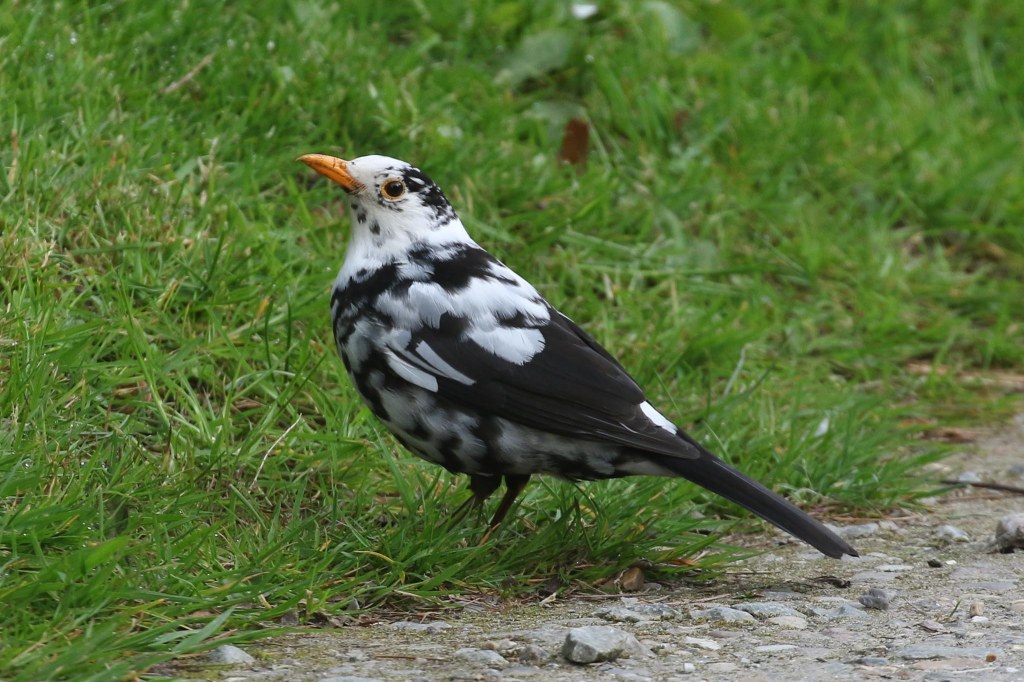
As we loaded up the minibus outside the B&B, the regular leucistic Blackbird was feeding along the driveway in front of us. It even came closer today, for a photo!
Once we got away, we headed down to the coast and stopped in Blakeney first. From up on the bank overlooking the harbour, we could see several small flocks of Brent Geese out on the saltmarsh. It didn’t take long to find the lingering Red-breasted Goose in with them, just the other side of the harbour channel. It was half hidden behind some thick grass at first, and harder to pick out with its head down feeding, but then it came out into full view. Stunning.
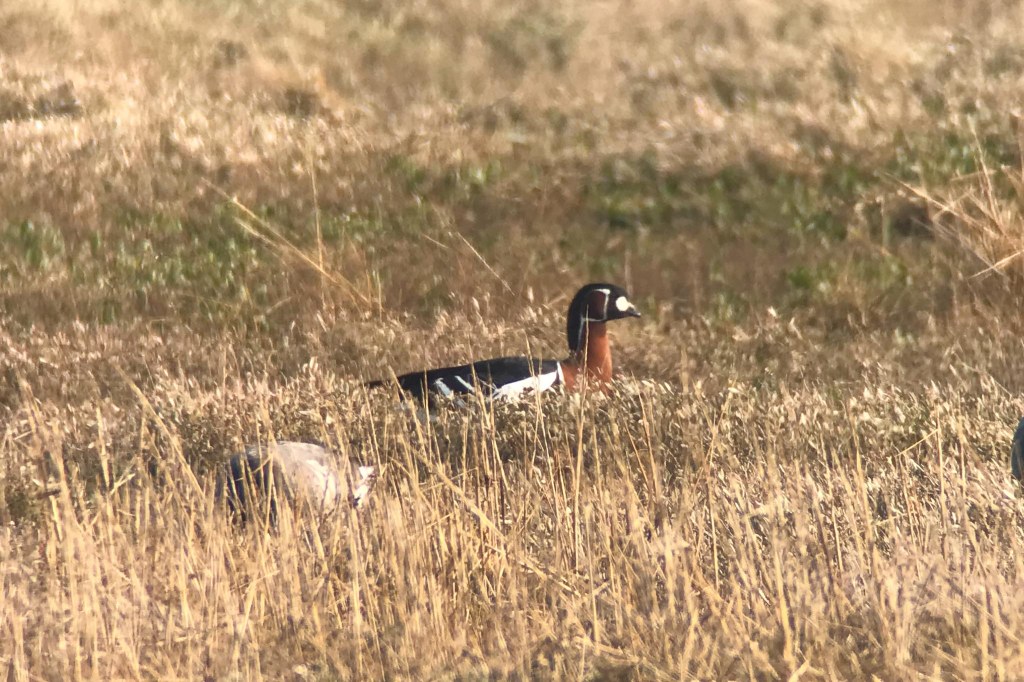
The Brent Geese are never in any great hurry to leave in the spring, so the Red-breasted Goose may stay with us for a few weeks yet. It will presumably then head back up to Siberia with them, where hopefully it will meet up with more Red-breasted Geese again. At one point, the Red-breasted Goose stopped feeding and started calling – we could hear it all the way over where we were standing. Presumably it is keen to find more of its own kind already.
A Curlew was feeding in the mud in the harbour channel. There were several Oystercatchers and Lapwings out on the saltmarsh beyond. We decided to move on. As we drove off through the village, we could see one of the Red-breasted Geese in the Blakeney wildfowl collection – unfortunately captive wildfowl doesn’t count!
Our next destination was Cley – we figured if it was going to be really windy today, we would at least be able to find shelter in the hides. We parked at the visitor centre, and walked over the road to the Skirts path. Several Sedge Warblers were singing in the reeds and song flighting. A Cetti’s Warbler shouted unseen from deep in the vegetation.
We turned in on the path to Bishop Hide, and first a Water Rail squealed from the reeds across the small pool, then we heard pinging and looked across to see a male Bearded Tit perched up in the reeds the other side. It remained there for a minute or so, then flew a bit nearer and landed up in the tops of the reeds again – great views. Eventually it flew across, over the path in front of us, and disappeared into the reeds the other side.
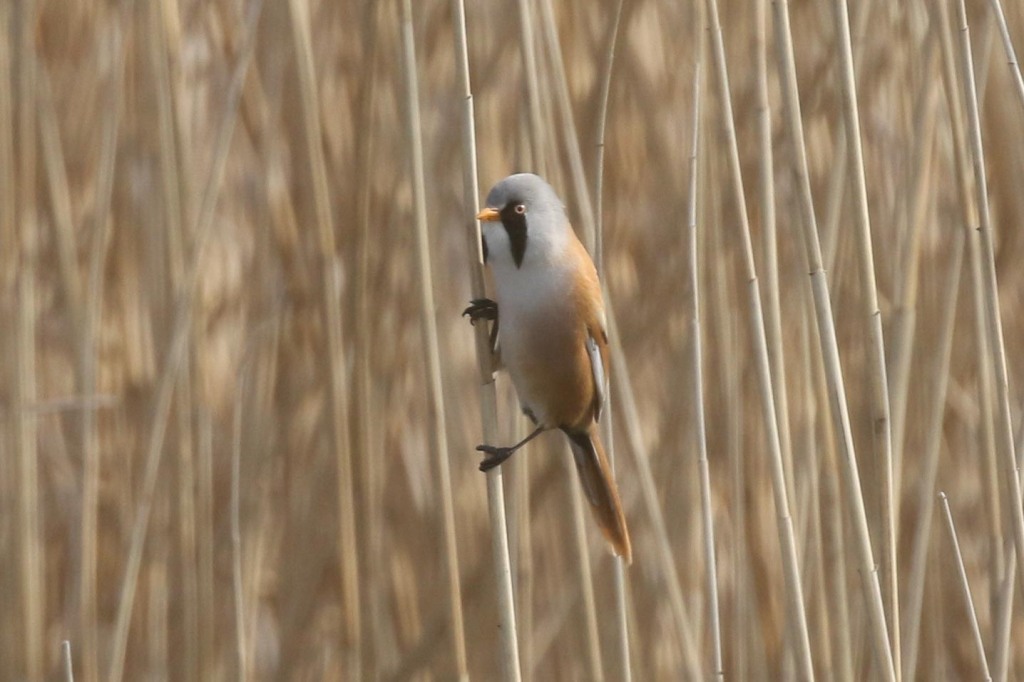
It can be very hard to find Bearded Tits when it is windy, as they stay low down in the reeds, but it was fairly sheltered along the path here and they have been very active here recently. Our main target for the morning here achieved already!
Into the hide, we opened the shutters very carefully and found various things on the bank right in front – a pair of Shelducks preening, an Oystercatcher probing in the grass, looking stunning close up, and a Lapwing briefly too – showing off its great irridescent colours as it turned in the morning sunshine.
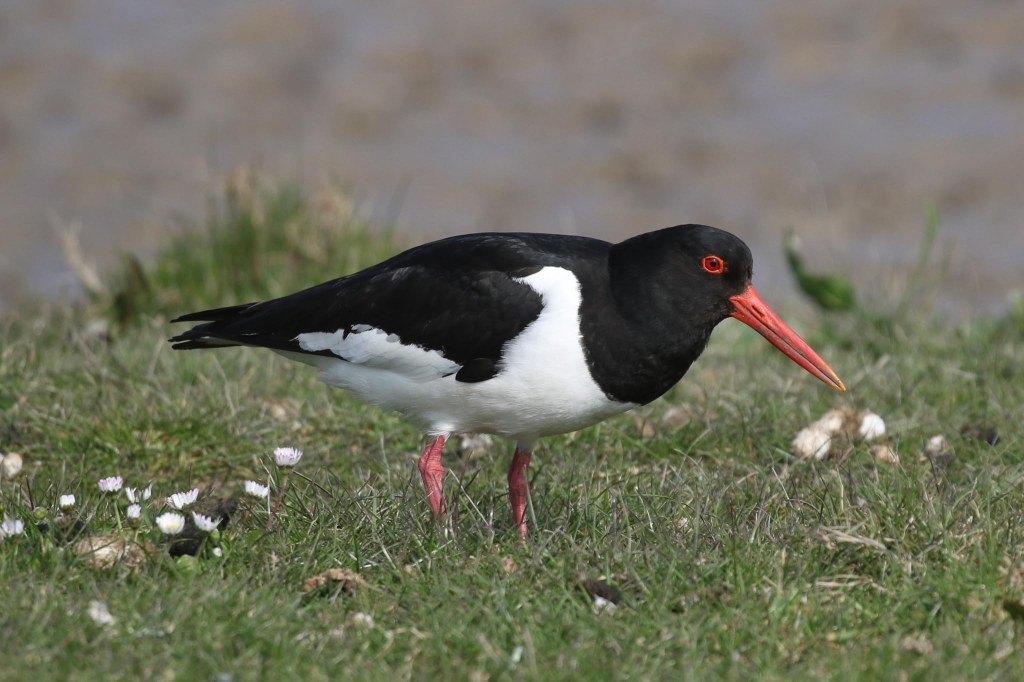
A little flock of Dunlin was feeding on the shallow mud further out on the scrape. They were very jumpy in the wind today, continually flying round and landing again. More kept flying in – by the end we couted at least 42. Most were still rather plain and grey, but several were already getting into breeding plumage, sporting black belly patches and richer brown fringed backs.
There were several Ruff feeding with the Dunlin in variety of sizes and colours. The females are much smaller than the males, so it was good to see them alongside each other now. The males are all moulting into breeding plumage, although not getting their ornate ruffs yet, and no two look alike. One male Ruff was quite advanced with bright brown and black summer body plumage.

There were lots of Black-tailed Godwits, mostly loafing around on the islands. In the water in front, were two Bar-tailed Godwits. They were almost in full summer plumage, bright rusty with the colour extending right down onto the belly and under the tail. There has been a big passage of Bar-tailed Godwits moving through the south of the UK, this week, and there birds were probably dropping in to feed out of the wind.
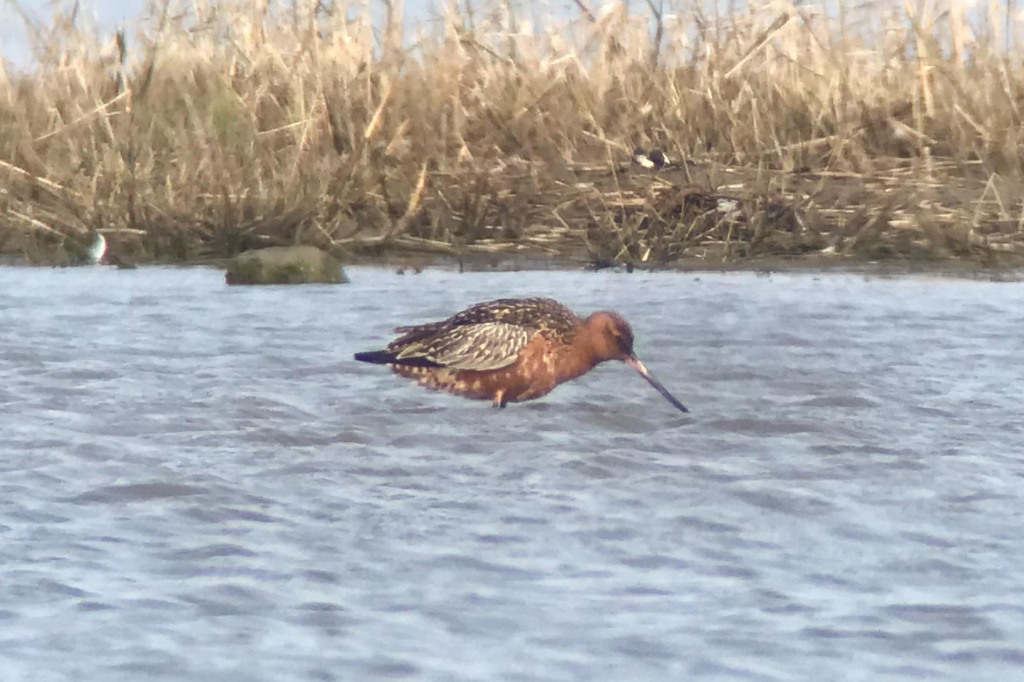
Various things flew over – a pair of Mediterranean Gulls flew round over the back of the scrape and dropped down behind the reeds beyond, a Swallow came over and we picked up a Common Snipe over the far hides which seemed to drop down on the scrapes there. Another Bearded Tit, a female this time, appeared briefly, low in the reeds on the edge of the ditch out to the right.
We made our way back out and round to the East Bank. We could hear Chiffchaff and Blackcap singing in the hedge over the road and several more Sedge Warblers in the reeds. Up on the bank, a Kestrel was ahead of us hovering and a smart male Marsh Harrier was circling over reeds. A quick scan of the grazing marsh revealed a pair of Wigeon on Pope’s Pool – they are very common here in the winter, but most of left now and there are just a few stragglers.
A Reed Warbler was singing quietly from the reeds on the edge of Don’s Pool, not really getting going yet either because it was fresh in or because of the wind or both. We could still hear the very rhythmical nature of its song, very different from the Sedge Warblers. A Little Grebe surfaced briefly. Some movement low down in the reeds across the water caught our eye – another pair of Bearded Tits working their way round the edge of the pool – who said they were going to be hard to see in the wind!
There were more waders on the Serpentine – more Black-tailed Godwits, Avocets, Ruff and several Redshanks. A couple of Ringed Plovers were feeding on the mud with two Dunlin. A Whimbrel was feeding in the long grass further back, but was very hard to see. There was another Bar-tailed Godwit nearby too, this one not yet in breeding plumage.
It was windy up on the East Bank, so when we got to Arnold’s Marsh, we stopped first in the lee of the shelter looking the other way and scanned the brackish pools. There were several Pintail on the water, busy upending, the smart drakes showing off their pin-shaped tails.
Then we braved the front of the shelter, facing straight into wind, and scanned the marsh itself. There were lots of Dunlin, Redshank, and a couple of Ringed Plover on here today. Six more Bar-tailed Godwits too – it was certainly a theme of the morning. A single Greenshank was feeding in the water right in the far corner. Two Sandwich Terns were preening in front of the shingle island in the middle at the back.
Having come this far, we couldn’t not go out to see the sea, particularly as it was obviously quite rough – we could see the tops of the waves breaking from here. There were some impressive waves breaking on the shingle. Looking out to sea, we picked up two Gannets and a Fulmar flying past in the distance. Then we decided to get out of the wind and head back.

Two more Bar-tailed Godwits flew in over the brackish pools as we passed, and dropped down onto Arnold’s. A male Redshank was displaying to a female on the pools just below the bank, but she obviously wasn’t impressed and flew off. The Whimbrel was now in a slightly more open area of grass out on Pope’s, so we got the scope on it again.
We made our way back to the Visitor Centre, where it wasn’t as windy as we thought it might be now and we stopped for lunch on the picnic tables. While we ate, we were treated to a nice display from a male Marsh Harrier the other side of the road.
After lunch, we made our way out to the main hides. We went in to Dauke’s Hide first and as we looked out a Spoonbill flew past right in front. There were more Black-tailed Godwits and a breeding plumage Bar-tailed Godwit with them again here, and several more Ruff. Five Greenshank came low over the scrape calling, and dropped down behind the reeds. A flock of Dunlin flew in. A Redshank right in front of the hide gave us some nice close views.

All the waders came up off Pat’s Pool, and as they flew over brought everything up off Simmond’s too. We couldn’t see what had caused them to spook, but they whirled round and most disappeared off over the reeds. We decided to have a look in Avocet Hide, and there was not much left here either. A pair of Teal were close in feeding, and we admired the smart male. A Marsh Harrier dropped into the grass over the back. Two Sand Martins came over – our first of the tour.
We walked back to visitor centre and drove round to Kelling. We thought it might be a bit more sheltered from the wind here. As we walked down the lane, we could hear Blackcap and Chiffchaff singing in the hedge. A female Tawny Mining Bee landed on the sandy track in front of us. A Brown Hare stopped and looked out from the furrows in the potato field next door. We stopped at the double gate to scan the south end of the Water Meadow. There were lots more Brown Hares out on the grassy slope beyond, and a couple of Red-legged Partridges.
Continuing on down to the pool, three more Sand Martins and a male Swallow were hawking low over the field by the track and over our heads. We could hear a Lesser Whitethroat singing the other side. There were a few ducks on the pool, but not much else, and the teenage gang of Mute Swans on the Quags the other side.
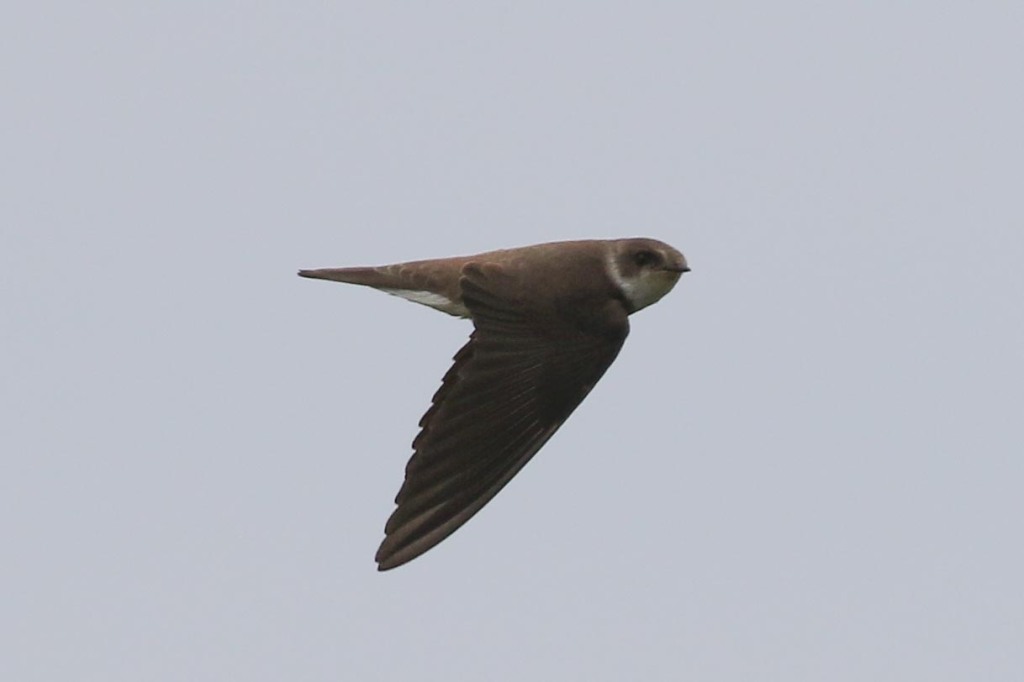
This is normally a great place for Common Whitethroat but the only one we heard today was sub-singing in the brambles on the way down to the beach, and wouldn’t show itself. Hopefully there are more still to return. A smart male Stonechat perched up on the brambles and a few Linnets flew back and forth.
Two Wheatears were feeding out on the short grass on the Quags, and a couple of young Great Black-backed Gulls were loafing on the pool behind. A Grey Plover and a couple of Ringed Plovers were down on one of the pools at the base of the shingle, but were flushed by walkers and disappeared over the ridge.

We walked up the permissive path up the hillside along the edge of Weybourne Camp. The old sandpit behind the beach, which used to be full of orchids and a favoured place for exhausted migrant birds to stop and feed, is now being used as a dump for builders’ waste. None of the group was very impressed with the signs which have been put up all along the fence on the Camp. Not a very welcoming impression to the county for visitors. We wondered what they might be conserving, certainly not the orchids!
Past the gun emplacements, two Skylarks landed on the grass airfield but there was nothing on the bushes around the old radar station. As we walked back down, a Swallow was resting on one of the concrete bunkers. Five Common Scoter were on the sea beyond, just over the shingle. Through the scope, we could see there were four males, black with yellow on their bills, and a browner pale-cheeked female.

Then we made our way slowly back up the lane to the minibus. It was time to call it a day. Another day tomorrow!
















